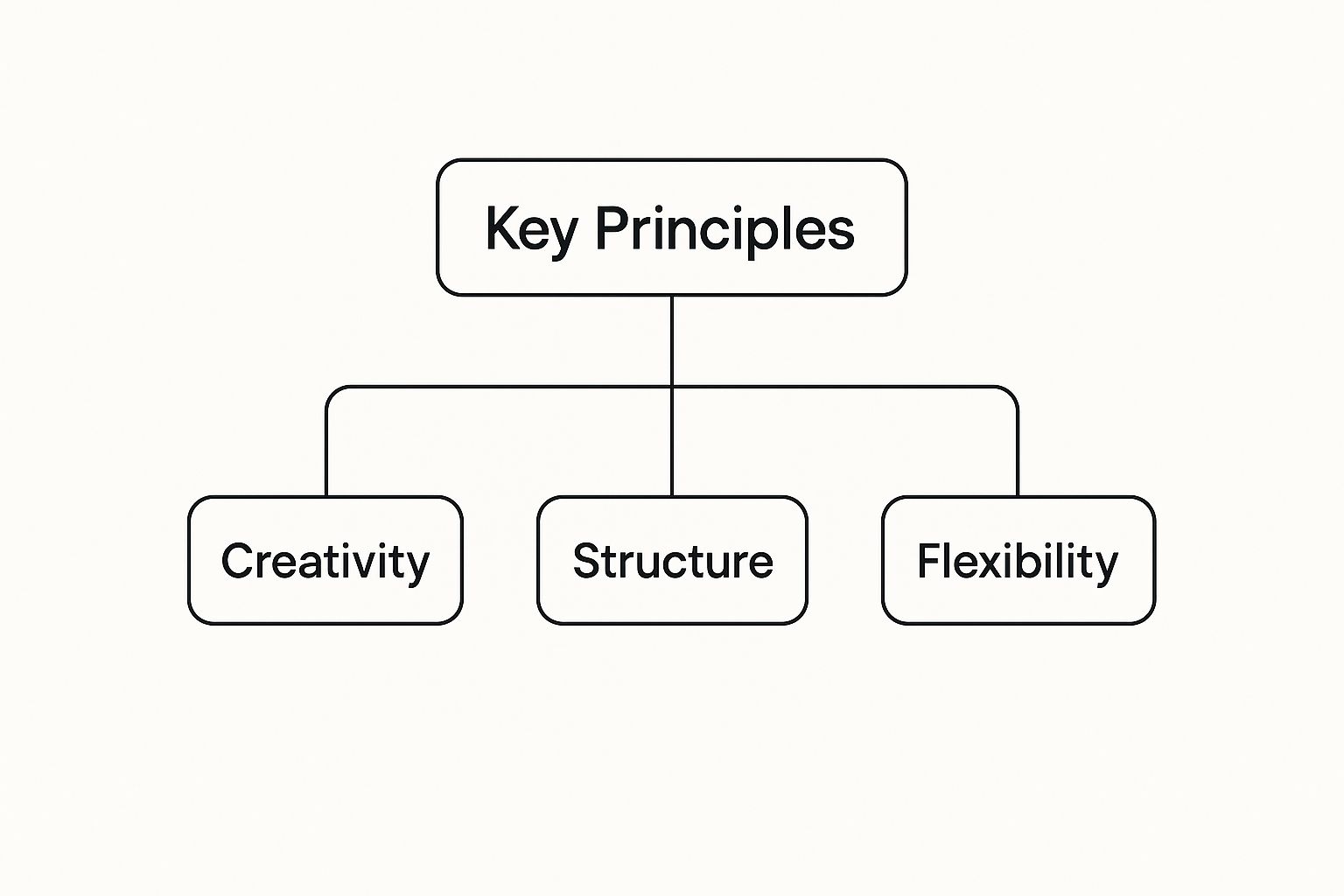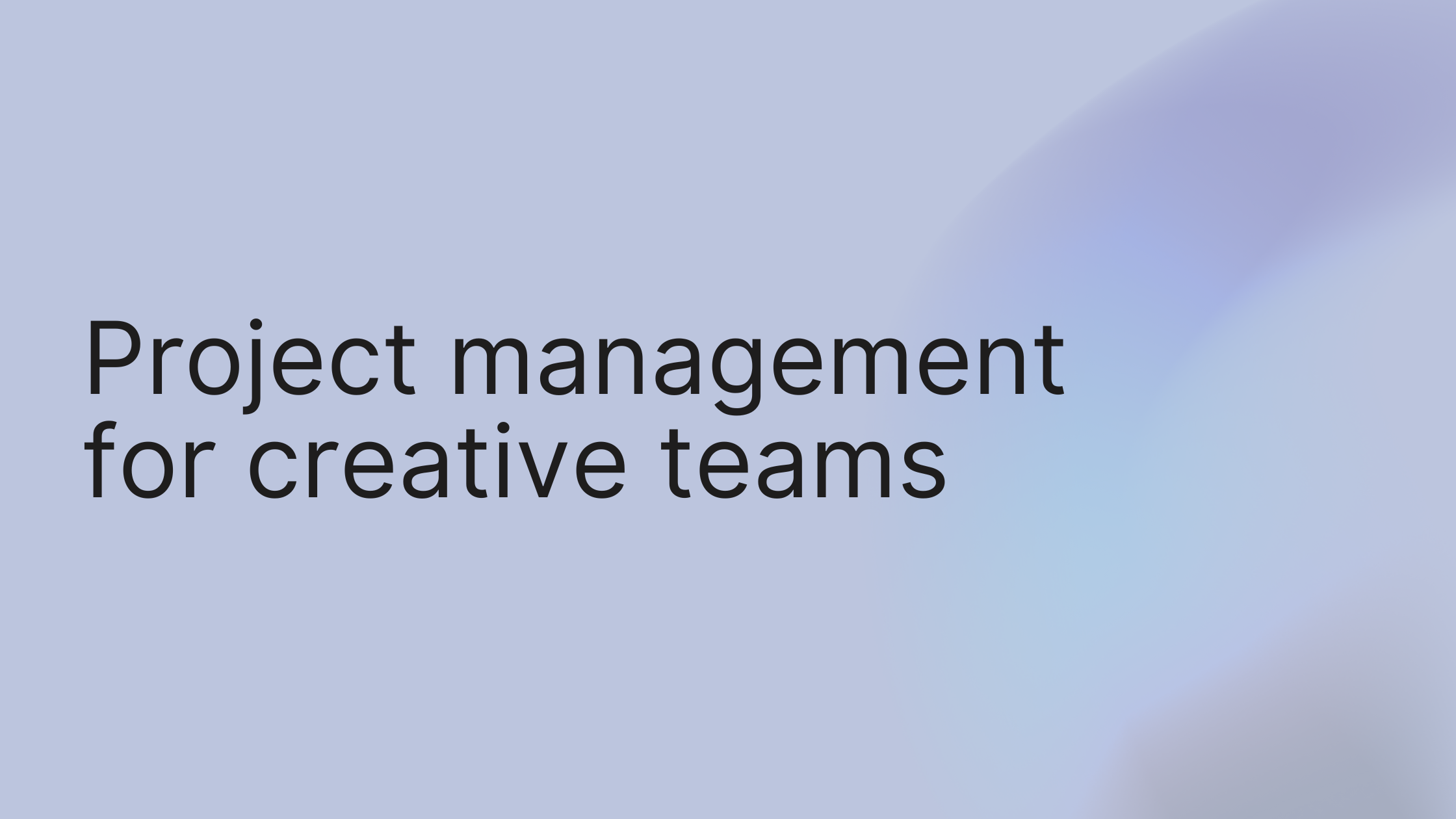Chasing down feedback, deciphering vague requests, and watching deadlines fly by—sound familiar? Managing creative projects often feels like herding cats in a hurricane. But what if you could calm the chaos with one simple change? The fastest way to bring order is to implement a rock-solid Creative Brief for every single project. It’s a simple document that aligns everyone on goals, deliverables, and what success looks like before the work even starts, saving you from endless revisions later.
Why Traditional Project Management Fails Creatives
Does the question, "Can you just make it pop?" send a shiver down your spine? For most creative teams, that kind of vague, subjective feedback is an everyday nightmare. It’s a telltale sign of a broken process, where old-school, rigid project management methods collide with the messy, iterative reality of creative work.
This constant tug-of-war with unclear expectations and moving targets isn't just frustrating—it’s a one-way ticket to burnout and mediocre results.
The fundamental issue is that systems built for predictable, assembly-line tasks (like building a bridge) simply don't work for the exploration and discovery needed in design, writing, or campaign development. When you try to cram a creative process into a rigid box, you suffocate the very space where brilliant ideas are born.
The Warning Signs of a Broken Process
If your team is constantly putting out fires, you might be using the wrong project management approach. See if any of these sound familiar:
The Never-Ending Revision Cycle: Projects get stuck in a feedback loop from hell, with endless minor tweaks that drain morale and blow the budget.
Constant Scope Creep: That "quick little change" someone asked for has somehow morphed into a massive overhaul, leaving your team scrambling to meet a deadline that's now impossible.
Communication Chaos: You have to hunt through a dozen emails, Slack threads, and meeting notes just to find the latest feedback or a crucial asset.
Creative Burnout: Your team spends more time navigating red tape than actually creating. When the process gets in the way of the work, passion dies, and your best people start looking for the door.
Step 1: Create a Bulletproof Creative Brief
The first actionable step to fix these problems is to start every project with a Creative Brief. Think of it as a contract for clarity between your team and stakeholders.
Here’s a step-by-step guide to building one:
Define the Objective: What business problem are we actually solving? (e.g., "Increase Q3 lead generation by 15%.")
Identify the Target Audience: Who, specifically, are we talking to? Get detailed. (e.g., "Marketing managers, age 30-45, at B2B SaaS companies.")
Nail the Key Message: If they remember only one thing, what should it be? (e.g., "Our software automates their most tedious tasks.")
List the Deliverables: What exact assets will be created? (e.g., "3 social media graphics, one 60-second video, one landing page.")
Outline Mandatories & Restrictions: What brand guidelines, logos, or legal copy must be included?
Pro Tip: The "Five Whys" Technique
When a stakeholder gives you a vague objective like "We need a new landing page," don't just accept it. Use the "Five Whys" technique to dig deeper. Ask "Why?" repeatedly until you uncover the root business problem (e.g., "Why?" "Because our conversions are low." "Why?" "Because users don't understand our value proposition."). This turns a tactical request into a strategic goal, ensuring your creative work solves a real problem.
By confronting these issues head-on, you can start building a system that champions creativity instead of constraining it.
Finding the Right Creative Project Management Method
Have you ever tried to run a gourmet kitchen with a fast-food playbook? It's a recipe for disaster. Picking a project management method for a creative team can feel exactly like that—trying to force a rigid system onto a group of people who thrive on flow and inspiration. The secret isn't finding a single "perfect" method. It's about understanding how your team actually works and choosing a framework that supports them, not one that boxes them in.
Let's stick with the kitchen analogy. What works for a high-volume food truck would bring a Michelin-star restaurant to its knees. So, let's break down the most popular models to see which one fits your team's unique flavor.
H3: Agile: The Fine-Dining Restaurant
Think of Agile as the meticulously planned fine-dining establishment. The entire project is like a multi-course tasting menu, broken down into smaller, defined stages called sprints—these are your individual courses. Each sprint has a clear goal, whether it's perfecting the appetizer or plating the main course.
This approach is built on structure and iteration. After each sprint, the team presents their work to stakeholders (the diners) for feedback before moving on to the next course. This makes it a fantastic choice for complex, long-term projects where the final vision is clear, but the details might evolve along the way. The potential downside? That same structure can feel a bit restrictive for creative teams who need to react to sudden bursts of inspiration or last-minute client requests.
This simple diagram shows the delicate balance required in any creative project. You're constantly juggling Creativity, Structure, and Flexibility.

The real takeaway here is that you can't sacrifice one for the others. A successful system finds harmony between all three.
H3: Kanban: The Fast-Paced Food Truck
Now, picture Kanban as a bustling food truck during the lunch rush. Work isn't planned in rigid, multi-week blocks. Instead, tasks are pulled from a backlog (the order queue) as soon as a team member has the capacity to start. It’s a visual, flow-based system that’s perfect for teams handling a steady stream of smaller, less predictable tasks—think of a design team fielding daily requests for social media graphics.
The biggest win here is its incredible flexibility. The core principle is to limit your "work in progress" (WIP) to prevent bottlenecks and burnout. You wouldn't start ten new orders if you only have two chefs on the line, right? But be warned: without a clear way to prioritize, important long-term goals can get endlessly pushed back in favor of "urgent" new tasks that pop up.
H3: The Hybrid Approach: Combining The Best Of Both
For many creative teams, the real magic happens somewhere in the middle. A hybrid model, often called "Scrumban," blends the structured sprints of Agile with the visual, flexible workflow of Kanban.
Imagine a team using a two-week sprint to focus on the major deliverables for a new website launch. At the same time, they use a Kanban-style board to manage the urgent bug fixes or minor content updates that inevitably appear. This way, they can protect their long-term focus while still being responsive.
Choosing the right methodology can feel daunting, so here’s a quick comparison to help you find the best starting point for your team.
Creative Project Management Methodologies Compared
Methodology | Best For | Key Benefit | Potential Drawback for Creatives |
|---|---|---|---|
Agile | Complex, long-term projects with clear milestones (e.g., app development, website redesign). | Predictability and stakeholder alignment through regular reviews. | Sprints can feel too rigid and stifle spontaneous creativity or urgent tasks. |
Kanban | Teams with a continuous flow of varied tasks (e.g., content creation, social media). | Extreme flexibility and visibility into workflow bottlenecks. | Important, non-urgent work can be ignored in favor of new requests. |
Hybrid | Teams that need to balance long-term project work with daily, unpredictable requests. | Combines structure for big goals with flexibility for day-to-day work. | Can be more complex to set up and requires clear rules to work effectively. |
Ultimately, the goal is to find a system that serves your team, not the other way around.
Interestingly, industry data supports this move toward blended approaches. A recent survey found that while 50% of teams using Agile methods also integrate other practices, a surprising 91% of project managers still report major challenges. This shows that the tool alone isn't a silver bullet—it has to be paired with the right process. After settling on a method, the next step is bringing it to life. You can learn more about creating project timelines that work in our dedicated guide.
Building a Bulletproof Creative Workflow
Does your day feel less like a creative session and more like a scavenger hunt? You know the drill—digging through old email threads for the project brief, scrolling endlessly through Slack for that one crucial piece of feedback, and trying to locate the actual final version of a file. It’s exhausting, inefficient, and an absolute momentum killer.
The solution is simpler than you think: create a Single Source of Truth (SSOT). This is just a fancy way of saying you need one central place where every brief, asset, comment, and approval lives. When you stop wasting brainpower on administrative chaos, you can pour all that energy back into what really matters—doing incredible work.
Step-by-Step Guide: The Creative Journey in Five Phases
An effective workflow isn't a rigid cage; it's a flexible roadmap guiding a project from fuzzy idea to polished final product. By breaking the process down into five clear, actionable phases, you can eliminate bottlenecks and keep everyone aligned.
1. The Discovery & Kickoff Phase
This is where you pour the foundation. Rushing this stage is a surefire recipe for scope creep and headaches.
Actionable Step: Finalize the Creative Brief and get official sign-off from all key stakeholders on objectives, deliverables, and timeline. In growlio, you can use a task template for this to ensure nothing is missed.
UI Call-out: Use the "Approval" feature in your project management tool to get a digital signature on the brief before marking the task complete.
2. The Ideation & Concepting Phase
With solid guardrails in place, your team can start exploring creative solutions.
Actionable Step: Develop 2-3 distinct concepts or rough drafts (e.g., mood boards, wireframes, copy outlines).
Actionable Step: Present these top ideas to the main stakeholder for directional feedback. The goal isn't a final sign-off, but to ensure you're pointed the right way before committing to heavy production.
This structured approach helps close a surprisingly common communication gap. One study found that while 94% of stakeholders believed they communicated project needs clearly, only 69% of creatives felt the same way. That 25% perception gap is where projects go off the rails.
From Concept to Completion
Once a direction is chosen, the project moves into production and review. This is where having clear, established processes is critical for keeping the momentum going.
3. The Production Phase
This is where your designers design, writers write, and developers build.
Actionable Step: Build out the project in a tool like Asana or Monday.com. Assign every task, set realistic deadlines, and define dependencies (e.g., design can't start until copy is approved).
UI Call-out: In growlio, keep all project-related conversations in the comments of the relevant task. This keeps communication contextual and ends the hunt through emails and Slack.
Here’s an example of how a project board in growlio can visualize your entire workflow, showing exactly what’s in progress, what's ready for review, and what’s complete.

This visual clarity means fewer "just checking in" meetings and more time for deep work.
4. The Review & Revision Phase
This is the stage where projects often grind to a halt. A defined review process is the only way to prevent this.
Actionable Step: Set a firm limit on revision rounds upfront (e.g., two rounds are included). Use a proofing tool that lets stakeholders leave consolidated feedback directly on the creative asset itself.
Actionable Step: Give stakeholders a clear deadline for feedback and set up automated reminders to prevent delays.
Pro Tip: Automate Your Review Cycle
Set up an automation in growlio to make your review process run itself. Create a rule where moving a task from "In Progress" to "In Review" automatically notifies the stakeholder and assigns them a subtask to "Provide Feedback" with a two-day deadline. This keeps the ball rolling without you having to manually chase anyone down.
5. The Delivery & Handoff Phase
A clean delivery process leaves a lasting positive impression.
Actionable Step: Package all final files into a neatly organized and clearly labeled folder structure.
Actionable Step: Send a final wrap-up message with a link to the assets and a quick summary of the project's success.
A bulletproof workflow comes down to a clear, repeatable process for every stage. If you want to dive deeper, exploring a dedicated content creation workflow that works for teams can offer even more insight.
Assembling Your Creative Technology Stack

Let’s be honest, is your team’s toolkit more of a digital junk drawer than a well-organized toolbox? It’s easy to collect powerful software, but if none of your tools talk to each other, your team ends up wasting its creative energy on manual data entry and toggling between a dozen open tabs. The real win isn't just buying more software; it’s making the tools you already have work together as one cohesive system.
Think of it this way: a master painter needs the right set of brushes that work in harmony, and a modern creative team needs a tech stack that does the same. The goal is to build a connected ecosystem where information flows automatically from one tool to the next. This creates an uninterrupted workflow, eliminates the tedious tasks everyone hates, and is absolutely fundamental to effective project management for creative teams.
The Core Components of Your Stack
A solid creative tech stack really boils down to four essential pillars. These are the foundational pieces that support every stage of your creative process, from the first spark of an idea to the final delivery.
Project Management Hub: This is your command center. It's the single source of truth where briefs, tasks, timelines, and all project-related communication live. A platform like growlio centralizes everything, giving your entire team the clarity and structure they need to do their best work.
Digital Asset Management (DAM): Stop the frantic searching for the latest version of a logo in a messy shared drive. A proper DAM system—whether it’s Google Drive, Dropbox, or a more specialized tool—organizes, stores, and controls access to all your precious creative files.
Communication Platform: While your project hub is great for conversations tied to specific tasks, you still need a place for quick, informal chats and team-wide announcements. This is where tools like Slack or Microsoft Teams shine.
Time-Tracking Software: This isn't about micromanaging. It's about gaining real insight. Good time tracking helps you understand project profitability, create smarter estimates for future work, and protect your team from burnout by making sure workloads are actually balanced.
Adopting these tools is a huge step forward. Data from early 2025 shows that 82% of companies use work and project management software to boost their efficiency. But here’s the kicker: less than a quarter (23%) use specialized project management software, which points to a massive opportunity for teams to get a real competitive edge.
Making Your Tools Talk to Each Other
The magic happens when you connect your tools through integrations. This is how you unlock automations that can save you countless hours. For creative teams juggling different brands, it's especially important to find tools that help them manage multiple social media accounts without losing their minds.
Mini Case Study: Automating Project Kickoffs
A small creative agency was wasting 30 minutes on manual setup for every new project. This involved creating a project in their management tool, making a new folder in Google Drive, and then sending a kickoff notification in Slack. By integrating their tools with growlio, they built a simple automation. Now, when a new project is created, it automatically:
Creates a matching project folder in Google Drive with their standard subfolder structure (e.g., /Briefs, /Assets, /Finals).
Posts a notification in their #new-projects Slack channel, tagging the assigned team members.
This small change saved them dozens of hours a month and let their team focus on strategy from minute one.
Pro Tip: Supercharge Your Asset Workflow with Integrations
You can take this a step further by connecting growlio directly with Google Drive. Set up an automation so that when someone attaches a file to a "Finals" task in a growlio project, that file is automatically copied to the correct "Finals" subfolder in the corresponding Google Drive project folder. This creates a bulletproof asset delivery system, eliminates manual file transfers, and ensures your DAM is always perfectly in sync with project progress.
A smart tech stack isn't about having the most tools; it's about having the right ones working together in perfect harmony.
A Real-World Agency Turnaround Story
Ever look at your team’s calendar and just feel your stomach sink? The endless late nights, the feedback coming from every direction, the nagging feeling that projects never truly end. That was the day-to-day reality for a talented design agency we’ll call "PixelPerfect Studios," who were brilliant at their craft but drowning in operational chaos.
Their story is a classic one. A constant storm of emails and Slack messages created a communication black hole where critical feedback and files would simply vanish. With no standardized revision process, client requests for "one tiny tweak" would balloon into days of unpaid work, leading to team burnout and plummeting profits. Their breakthrough didn't come from a magic bullet; it came from finally admitting their process was broken and committing to building a better one.
The Diagnosis of Chaos
Before they could fix anything, PixelPerfect had to get brutally honest about the symptoms. An internal audit brought three all-too-common failures to light:
Communication Breakdown: There was no single source of truth. Briefs were in one email, assets were in another, and feedback was scattered across five different Slack channels. Every task began with a frustrating scavenger hunt.
No Defined Revision Process: Clients could ask for changes at any time, from any person. This led to conflicting feedback and never-ending revision cycles. Scope creep wasn't just happening; it was destroying their timelines and morale.
Inconsistent Project Kickoffs: Some projects started with a detailed brief, while others kicked off with a vague verbal request. This inconsistency set every project up for failure from the start because the team was never clear on the actual goals or deliverables.
This complete lack of structure was the real villain of their story. They had a crucial realization: good project management for creative teams isn't about boxing in creativity. It’s about building a sturdy container for it to flourish.
The Step-by-Step Turnaround
With a clear diagnosis in hand, the PixelPerfect team rolled out a focused, step-by-step solution. They didn't try to change everything at once. Instead, they attacked the three biggest pain points with high-impact changes.
They adopted a Kanban board in growlio. All project tasks and communications were moved into a central hub. Each project got its own visual Kanban board with clear stages:
To Do,In Progress,Internal Review,Client Review, andApproved. This simple move brought immediate clarity—everyone knew who was doing what and exactly where every task stood.They standardized their creative briefs. The team created a mandatory creative brief template right inside growlio. No project could officially start until the client filled it out, locking in the scope, deliverables, and success metrics from day one.
They implemented a "Two-Round" revision policy. This was the real game-changer. They clearly stated in every single proposal that projects included two consolidated rounds of revisions. Any further changes would be billed hourly. This simple policy gave them the confidence to professionally push back on scope creep and restored respect for the team's time.
Pro Tip: Use Task Dependencies for Smarter Reviews
To really make their new revision policy stick, PixelPerfect used task dependencies in growlio. They set up the "Client Review" task to block the "Final Polish" task. This meant designers literally couldn't start final tweaks until the client officially marked their consolidated feedback as complete. It was a simple, automated way to stop piecemeal changes for good.
This new, structured approach didn't stifle their work. It liberated them.
The Tangible "Before and After"
The results weren't just a feeling of being less stressed; they were measurable and profound. Within just one quarter of implementing these changes, PixelPerfect saw:
A 30% reduction in average project completion time.
A 50% drop in overtime hours logged by the creative team.
A 40% increase in project profitability, mostly from eliminating unpaid scope creep.
Their story is a powerful blueprint. By combining clear processes with the right tools, they went from a team on the verge of burnout to a streamlined, profitable creative powerhouse.
How to Measure Creative Project Success

So, how do you actually know if a creative project was a success? If your only answer is, "Well, the client seemed happy," you’re not only selling your team short but also setting them up for future problems. When you rely purely on feelings, it becomes almost impossible to justify a bigger budget, protect your team from burnout, or even figure out how to do better next time.
The best way forward is to move from subjective feelings to objective data. If you’re just starting out, track one simple thing: the Number of Revision Cycles. This single metric can instantly shine a light on problems with your creative briefs, communication gaps, or a project that's creeping out of scope.
Measuring success isn't about micromanaging every little detail. It's about making smarter, evidence-based decisions. It gives you the hard data you need to have meaningful conversations with leadership and prove just how efficient and impactful your team really is. This is a fundamental part of leading any creative team.
Key Performance Indicators for Creative Health
Let's get past the fluff and vanity metrics. The most insightful Key Performance Indicators (KPIs) for creative teams are the ones that measure the health of your process and your people. Here are a few essential ones you can start tracking right away.
1. On-Time Delivery Rate
This one is straightforward but powerful. It measures your team's reliability and shows how good you are at estimating timelines.
- Actionable Step: In growlio, assign a due date to the final project deliverable. At the end of the month, run a report to see how many projects hit that original deadline using the formula:
(Projects Delivered On Time / Total Projects) x 100.
2. Number of Revision Cycles
A high number of revisions is a huge red flag. It often points directly to a vague brief, muddled communication, or a project whose scope is getting out of hand. Your goal should be to keep this number consistently low.
- Actionable Step: On your Kanban board, create distinct stages like
Client Review. Every time a project gets kicked back fromClient Reviewto anIn Progressstage, that counts as one revision cycle. Track this number per project.
Mini Case Study: Using Data to Improve Briefs
A content marketing agency noticed their average revision cycles were creeping up to four per project, causing major delays. By digging into this KPI, they discovered that projects with a vague "Audience" section in the brief had 75% more revisions. They immediately overhauled their briefing template to require a detailed audience persona. The result? They cut their average revision cycles in half within just two months.
Measuring Financial and Team Well-being
Beyond deadlines and endless edits, you absolutely have to keep an eye on your budget and your team's workload.
3. Budget Variance
This metric tells you if you're scoping and pricing your work correctly. If you're consistently seeing a negative variance, it means you're bleeding money on your projects.
- Actionable Step: Log every project-related expense and all billable hours in a central place, like growlio's finance hub. Then, compare the final cost against your initial proposal to calculate the variance using the formula:
(Actual Budget - Planned Budget) / Planned Budget x 100.
4. Team Utilization Rate
This shows you how much of your team's available capacity is being spent on billable work. It's critical for spotting burnout before it happens and for making smart hiring decisions. Keeping this metric healthy requires open and honest dialogue; you can learn more in our guide covering client communication best practices.
- Actionable Step: Use a platform with integrated time-tracking to log hours against specific projects. Dashboards in growlio can then give you a visual breakdown of utilization rates for every person on the team.
Pro Tip: Set KPI Thresholds and Alerts
Don't just track these numbers—do something with them. In growlio, you can set up automated alerts. Imagine getting a notification if a project enters its third revision cycle, or if its logged time blows past 80% of the budget. This lets you step in and solve a problem before the project goes completely off the rails.
By tracking these core metrics, you gain a new language to prove your team's value. You'll be building a creative operation that's more sustainable, more efficient, and ultimately, more creative.
A Few Common Questions About Creative Project Management
Ever had that client who loves to say, "Could you just add one more thing?" We've all been there. That slow, constant expansion of a project's boundaries, known as scope creep, can completely wreck your timeline and leave your team feeling exhausted.
One of the best ways to get ahead of this is to build a change request process directly into your initial contract. It gives you a professional, pre-approved way to address new ideas without making things awkward or straining the relationship. Let's tackle this and a few other common hurdles creative teams face.
How Do You Manage Client Scope Creep?
The best defense is a good offense. You can stop most scope creep in its tracks by being proactive from the very beginning.
When you draft your initial proposal and contract, include a "Change Order" clause. This isn't about being rigid; it's about being clear. It should spell out a few key things:
Exactly how many rounds of revisions are included in the price (e.g., two full rounds).
Any work requested that falls outside the original agreement will require a formal change order.
This change order will outline the new work, the additional cost, and how it will affect the project timeline, and it will need the client's signature before you start.
This sets clear expectations and protects both you and the client from misunderstandings down the road.
How Do You Handle Feedback From Multiple Stakeholders?
Getting feedback from a client's entire team can feel like being pulled in ten different directions at once. The marketing lead wants one thing, the sales director wants another, and the CEO has a completely different idea.
The solution is simple: insist on a single point of contact. Make it clear that one person on their team is responsible for gathering, consolidating, and resolving any internal conflicts before the feedback ever reaches you. They deliver one clear, final set of notes.
Mini Case Study: A small branding agency was getting bogged down by contradictory notes from a client's marketing, sales, and executive teams on every project. By enforcing a "single point of contact" rule, they shifted the responsibility of resolving internal disagreements back to the client. This one simple change cut their revision time by an average of 30% and brought much-needed clarity to the process.
How Can a Freelancer Adopt These Principles?
You don't need a big team to benefit from a solid process. In fact, for freelancers, good structure is what keeps you sane and profitable. The trick is to keep it lightweight and effective.
Here's how a team of one can do it:
Always Use a Creative Brief: Don't skip this, even for small jobs. A brief is your project's constitution and your best defense against scope creep.
Set Up a Simple Kanban Board: A basic
To Do,In Progress, andIn Reviewboard in a tool like growlio gives you a visual snapshot of all your work. It's clarity at a glance.Establish Clear Boundaries: From the very first conversation, communicate your revision policy and your standard working hours. It sets a professional tone and manages expectations.
Ready to stop the chaos and start building a more streamlined, profitable creative process? Take the first step today.
Start a free growlio account and turn your creative workflow into your competitive advantage.
